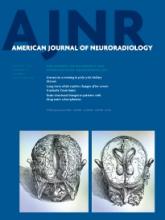Abstract
BACKGROUND AND PURPOSE: Absence of the MCA susceptibility vessel sign (negative MCA susceptibility vessel sign) on gradient recalled-echo MR imaging in acute stroke is commonly associated with in situ stenosis and thrombotic occlusion. We evaluated the effectiveness and safety of the Solitaire stent as the first-line device for the recanalization of MCA occlusion with a negative MCA susceptibility vessel sign.
MATERIALS AND METHODS: Thirty-eight consecutive patients presenting with acute ischemic stroke due to MCA occlusion were treated by using the Solitaire AB stent alone or combined with thrombolytic drugs. Among these patients, 11 (7 men and 4 women; median age, 70 years; range, 49–89 years) who underwent multimodal stroke MR imaging before the endovascular procedure and had no MCA susceptibility vessel sign on the initial gradient recalled-echo MR imaging were included in this study. The primary end point was the recanalization of the occluded artery evaluated by the arterial occlusive lesion score. Clinical outcome was assessed at discharge and 90 days, as was the degree of residual MCA stenosis or reocclusion.
RESULTS: Successful recanalization (arterial occlusive lesion score ≥ II) without balloon angioplasty was obtained in 9 patients (81.8%). Six patients (54.5%) had an mRS score of ≤2 at 90 days. After a median of 147 days, no patient showed reocclusion on follow-up imaging. There were no symptomatic intracerebral hemorrhages.
CONCLUSIONS: The Solitaire stent is a feasible tool as the first-line device for multimodal endovascular recanalization therapy in acute ischemic stroke with a negative MCA susceptibility vessel sign. It has a good rate of successful and complete recanalization and is a fast yet safe procedure.
ABBREVIATIONS:
- GRE
- gradient recalled-echo
- SVS
- susceptibility vessel sign
- © 2014 by American Journal of Neuroradiology











